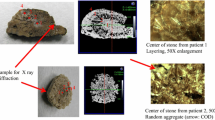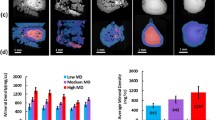Abstract
Although most kidney stones are found in the calyx, they are usually initiated upstream in the nephron by precipitation there of certain incipient mineral phases. The risk of kidney stone formation can thus be indicated by changes in the degree of saturation of these minerals in the nephron fluid. To this end, relevant concentration profiles in the fluid along the nephron have been calculated by starting with specified urine compositions and imposing constraints from the corresponding, much less variable, blood compositions. A model for supersaturation within ten sections of both long and short nephrons has accordingly been developed based on this ‘reverse engineering’ of the necessary substance concentrations coupled with chemical speciation distributions calculated by our Joint Expert Speciation System (JESS). This allows the likelihood of precipitation to be assessed based on Ostwald’s ‘Rule of Stages’. Differences between normal and stone-former profiles have been used to identify sections in the nephron where conditions seem most likely to induce heterogeneous nucleation.



Similar content being viewed by others
References
Grases F, Costa-Bauzá A, Garcia-Ferragut L (1998) Biopathological crystallization: a general view about the mechanisms of renal stone formation. Adv Colloid Interface Sci 74:169–194
Kallidonis P, Liourdi D, Liatsikos E (2011) Medical treatment for renal colic and stone expulsion. Eur Urol Suppl 10:415–422
Tiselius HG (2011) Who forms stones and why? Eur Urol Suppl 10:408–414
Hill MG, Königsberger E, May PM (2017) Mineral precipitation and dissolution in the kidney. Am Mineral 102:701–710
Tiselius HG (1982) An improved method for the routine biochemical evaluation of patients with recurrent calcium oxalate stone disease. Clin Chim Acta 122:409–418
Milosevic D, Batinic D, Konjevoda NBP, Stambuk N, Votava- Raic A, Fumic VBK, Rumenjak V, Stavljenic-Rukavina A, Nizic L, Vrljicak K (1998) Determination of urine supersaturation with computer program Equil 2 as a method for estimation of the risk of urolithiasis. J Chem Inf Comput Sci 38:646–650
Laube N, Schneider A, Hesse A (2000) A new approach to calculate the risk of calcium oxalate crystallization from unprepared native urine. Urol Res 28:274–280
Hill MG (2019) A chemical model to investigate the risk of kidney stone formation in humans in terms of urinary supersaturation. PhD thesis, Murdoch University
Rodgers AL, Allie-Hamdulay S, Jackson G, Tiselius HG (2011) Simulating calcium salt precipitation in the nephron using chemical speciation. Urol Res 39:245–251
Robertson WG (2015) Potential role of fluctuations in the composition of renal tubular fluid through the nephron in the initiation of Randall’s plugs and calcium oxalate crystalluria in a computer model of renal function. Urolithiasis 43(Supplement 1):S93–S107
Tiselius H, Lindbäck B, Fornander AM, Nilsson MA (2009) Studies on the role of calcium phosphate in the process of calcium oxalate crystal formation. Urol Res 37:181–192
Højgaard I, Tiselius HG (1999) Crystallization in the nephron. Urol Res 27:397–403
Tiselius HG (1997) Estimated levels of supersaturation with calcium phosphate and calcium oxalate in the distal tubule. Urol Res 25:153–159
Kok DJ (1997) Intratubular crystallization events. World J Urol 15:219–228
Söhnel O, Grases F (1995) Calcium oxalate monohydrate renal calculi. Formation and development mechanism. Adv Colloid Interface Sci 59:1–17
Grases F, Costa-Bauzá A, Gomila I, Ramis M, García-Raja A, Prieto RM (2012) Urinary pH and renal lithiasis. Urol Res 40:41–46
Robertson WG, Scurr DS, Bridge CM (1981) Factors influencing the crystallisation of calcium oxalate in urine–critique. J Cryst Growth 53:182–194
Tiselius HG (2011) A hypothesis of calcium stone formation: an interpretation of stone research during the past decades. Urol Res 39:231–243
Rodgers A, Webber D, Hibberd B (2015) Experimental determination of multiple thermodynamic and kinetic factors for nephrolithiasis in the urine of healthy controls and calcium oxalate stone formers: does a universal discriminator exist? Urolithiasis 43:479–487
Coe FL, Evan A, Worcester E (2011) Pathophysiology-based treatment of idiopathic calcium kidney stones. Clin J Am Soc Nephrol 6:2083–2092
Baumann JN, Affolter B (2014) From crystaluria to kidney stones, some physicochemical aspects of calcium nephrolithiasis. World J Nephrol 3:256–267
Söhnel O, Grases F (2011) Supersaturation of body fluids, plasma and urine, with respect to biological hydroxyapatite. Urol Res 39:429–436
Asplin JR, Mandel NS, Coe FL (1996) Evidence for calcium phosphate supersaturation in the loop of Henle. Am J Physiol 270:F604–F613
Luptak J, Bek-Jensen H, Fornander AM, Højgaard I, Nilsson MA, Tiselius H (1994) Crystallization of calcium oxalate and calcium phosphate at superstauration levels corresponding to those in different parts of the nephron. Scan Microsc 8:47–62
Grases F, Villacampa AI, Söhnel O, Königsberger E, May PM (1997) Phosphate composition of precipitates from urine-like liquors. Cryst Res Technol 32:707–715
Johnsson MSA, Nancollas GH (1992) The role of brushite and octacalcium phosphate in apatite formation. Crit Rev Oral Biol Med 3:61–82
Pak CYC (1969) Physicochemical basis for formation of renal stones of calcium phosphate origin: calculation of the degree of saturation of urine with respect to brushite. J Clin Investig 48:1914–1922
Pak CYC (1981) Potential etiologic role of brushite in the formation of calcium (renal) stones. J Cryst Growth 53:202–208
Pak CYC, Rodgers K, Poindexter JR, Sakhaee K (2008) New methods of assessing crystal growth and saturation of brushite in whole urine: effect of pH, calcium and citrate. J Urol 180:1532–1537
Coe FL, Parks JH, Nakagawa Y (1992) Inhibitors and promoters of calcium oxalate crystallization. their relationship to the pathogenesis and treatment of nephrolithiasis. In: Coe FL, Favus MJ (eds) Disorders of bone and mineral metabolism, vol 35. Raven Press Ltd, New York, pp 757–799
Rabadjieva D, Tepavitcharova S, Sezanova K, Gergulova R (2016) Chemical equilibria modeling of calcium phosphate precipitation and transformation in simulated physiological solutions. J Solut Chem 45:1620–1633
Sawada K (1997) The mechanisms of crystallization and transformation of calcium carbonates. Pure Appl Chem 69:921–928
Zhang J, Wang L, Putnis C (2019) Underlying role of brushite in pathological mineralization of hydroxyapatite. J Phys Chem B 123:2874–2881
Atherton JC (2006) Function of the nephron and the formation of urine. Anaesth Intensive Care Med 7:221–226
Good DW, Knepper MA (1985) Ammonia transport in the mammalian kidney. Am J Physiol 248:F459–F471
May PM, Murray K (1991) JESS, a Joint Expert Speciation System—I. Raison d’être. Talanta 38:1409–1417
May PM, Murray K (1991) JESS, a Joint Expert Speciation System—II. The thermodynamic database. Talanta 38:1419–1426
May PM (2015) JESS at thirty: strengths, weaknesses and future needs in the modelling of chemical speciation. Appl Geochem 55:3–16
May PM, Rowland D (2018) JESS, a Joint Expert Speciation System—VI: thermodynamically-consistent standard Gibbs energies of reaction for aqueous solutions. N J Chem 42:7617–7629
Cavan D, Hovorka R, Hejlesen O, Andreassen S, Sonksen P (1996) Use of the DIAS model to predict unrecognised hypoglycaemia in patients with insulin dependent diabetes. Comput Methods Prog Biomed 50:241–246
Hill M (2010) A personal experience of using computer technology to assist with the treatment of diabetes. In: Proceedings of the UKACC international conference on control, Coventry, UK, pp 417–422. https://doi.org/10.1049/ic.2010.0319
Author information
Authors and Affiliations
Corresponding author
Ethics declarations
Conflict of interest
The authors declare that they have no conflict of interest.
Appendix
Appendix
A computer program has been developed using the programming language Ada to simulate the ultrafiltration and reabsorption processes in the kidney. A matrix of reabsorption factors has been constructed from published data to quantify what proportion of the original amount of the substances under consideration entering the Bowman’s space via ultrafiltration is reabsorbed [8]. Every substance is associated with a sequence of values representing the reabsorption quantity in each of the ten segments of the nephron. The following function is used to work out the change in amount of substance, y, in the fluid in the lumen using the values in the matrix, R:
where \(y^i_0\) is the amount of substance i that enters the Bowman’s space via ultrafiltration; \(y^i_{s}\) is the amount of substance i at the end of the nephron section under consideration; \(y^i_{s-1}\) is the amount of substance i at the end of the previous nephron section; R[s, i] is the percentage of substance i reabsorbed in the nephron section under consideration.
An analogous equation applies to the total volume of the solution which is needed to calculate the concentrations of the substances under consideration.
The calculations given in this paper represent a particular snap shot of current knowledge and it is important to understand that changes will no doubt be made in future to deal with matters such as improved equilibrium constants, changes in the reabsorption factors and other areas where improved information becomes available.
To implement the ‘reverse model’, adjustments are made to the values in the reabsorption matrix, the value of the adjustment applied is calculated from the ratio of concentration in the urine under consideration and the urine concentrations produced using the standard reabsorption values, to alter the final result for the urine values to the specified value.
Tables 3, 4 and 5 show the total concentrations of the substances under consideration along the length of the nephron for the three sets of subjects used in this paper.
A copy of the computer program may be requested by contacting the corresponding author.
Rights and permissions
About this article
Cite this article
Hill, M.G., Königsberger, E. & May, P.M. Predicting the risk of kidney stone formation in the nephron by ‘reverse engineering’. Urolithiasis 48, 201–208 (2020). https://doi.org/10.1007/s00240-019-01172-8
Received:
Accepted:
Published:
Issue Date:
DOI: https://doi.org/10.1007/s00240-019-01172-8




